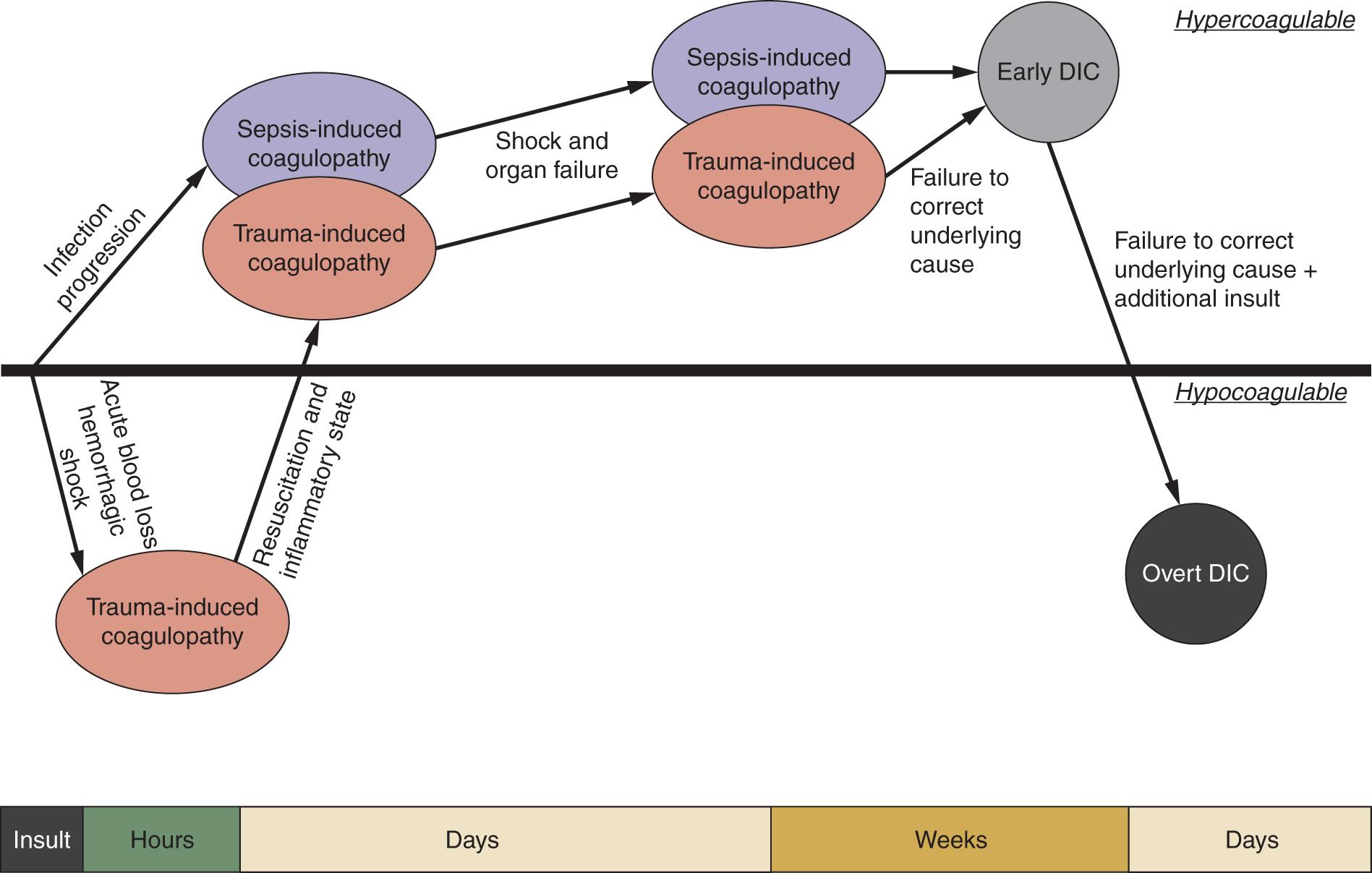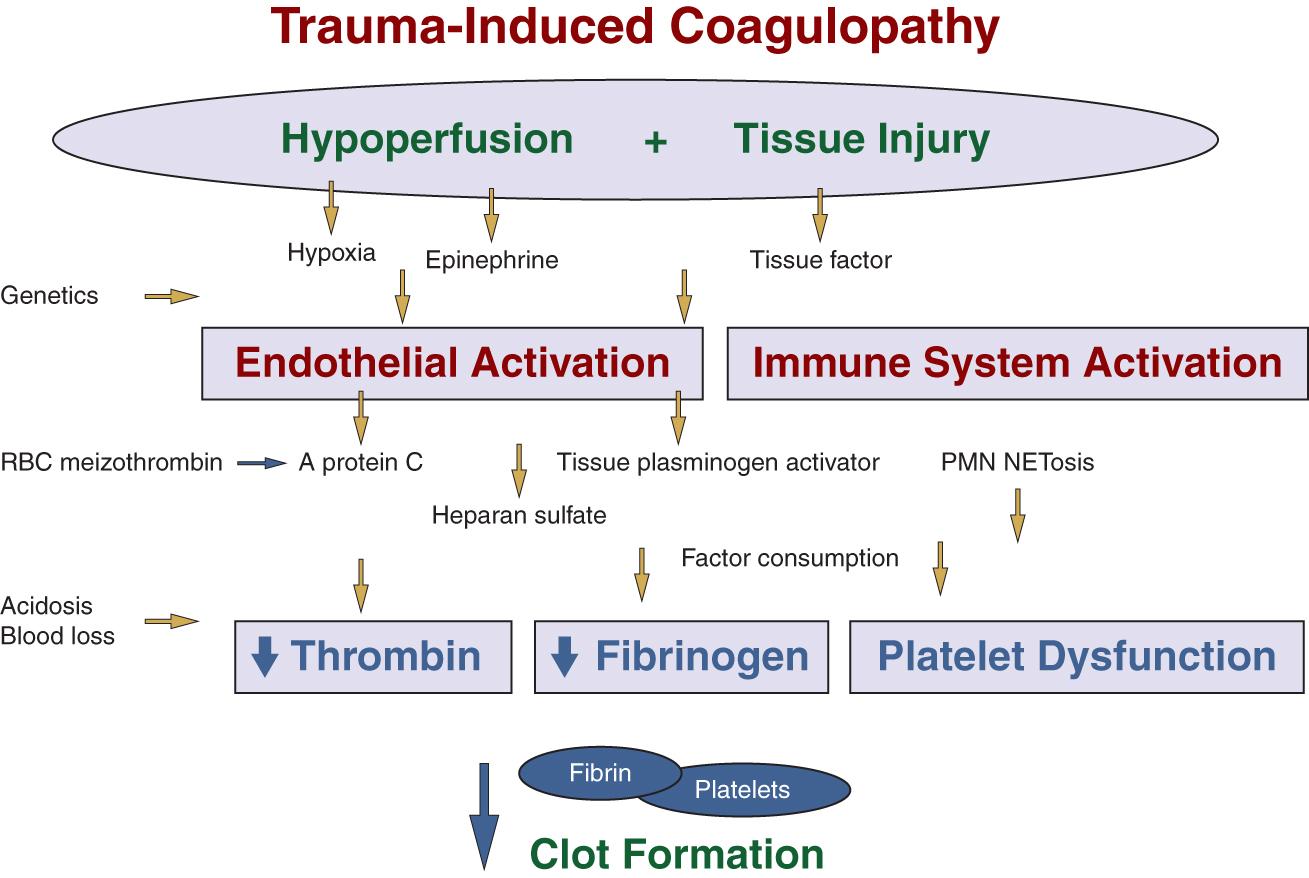Physical Address
304 North Cardinal St.
Dorchester Center, MA 02124
Noncardiac intensive care units (ICUs) predominantly manage coagulopathy in patients with trauma or sepsis. Although trauma is known as the third most frequent cause of death in the United States, sepsis, which is not as well categorized, is believed to be the leading cause of death in hospitalized patients. Both patient populations are at risk of developing coagulation abnormalities. However, the drivers of pathology and timing are divergent. Trauma-induced coagulopathy (TIC) occurs within minutes to hours after injury, whereas sepsis-induced coagulopathy (SIC) represents a spectrum of patients who have been ill days to weeks before progressing to coagulopathy associated with adverse outcomes ( Fig. 22.1 ). Attempting to assimilate the early drivers of coagulation changes between sepsis and trauma have highlighted discordances during the early phases of each disease process. Therefore the approaches to the initial management of coagulopathy in trauma and sepsis are divergent. Whereas trauma research has focused on promoting coagulation, sepsis investigation has tested antithrombotic therapy such as activated protein C and antithrombin. However, the crosstalk between TIC and SIC shares a common historical origin with the term disseminated intravascular coagulation (DIC).

The early descriptions of coagulation changes during hemorrhagic shock date back to the 1770s. Hewson observed that the last blood drawn in sheep clotted first. Almost 150 years later Cannon and Mendenhall validated this finding in which he observed clotting time in dogs was decreased with progressive hemorrhage. This early onset of hypercoagulability led numerous investigators to attribute hypercoagulability as the driving mechanism for irreversible shock after hemorrhage. , Histologic evaluation of these animals demonstrated microvascular thrombi, and the term DIC was introduced to the literature. Hardaway and colleagues had a long-term interest in DIC driving irreversible shock and demonstrated that pretreating animals with heparin before hemorrhage could effectively reverse DIC-attributable death. They also demonstrated that a fibrinolytic agent could have the same effect of reversing lethal shock when delivered during resuscitation. Hardaway’s group later documented intravascular clots in patients with organ failure in 1965.
In 1969 Cafferata and colleagues provided the most compelling evidence of DIC in humans, with a observational postmortem examination of 12 patients who failed to resuscitate several days after injury, despite gaining surgical hemostasis. All 12 patients had clinical evidence of oozing and low-grade bleeding during the perimortem period; however, 8 of these patients had thrombi in their lungs. In the 1970s it was shown that endotoxin infusion could also drive organ failure associated with microvascular clots in animal models. This was then appreciated in patients with cancer, in which it was observed that treating patients with heparin had no effect on outcomes, as the underlying malignancy drove microthrombosis. These early studies set the foundation for decades of research in DIC driving coagulopathy in the critically ill. The laboratory diagnosis of DIC can be misleading, as intravascular microthrombi in a large autopsy series were evident in only 60%.
A review of the interconnectivity of the inflammation and coagulation leading to excessive fibrin deposition and organ failure was published in the New England Journal of Medicine in 1999. Twenty years later, as the COVID-19 pandemic overwhelms the healthcare system worldwide with concerns for a lethal cytokine storm, autopsy reports from these patients demonstrate thrombi deposition in multiple organ systems. The most worrisome aspect of DIC is that it heralds the initiation of end-stage organ failure, with no effective treatment, and remains a cause of irreversible shock, as reported by Hardaway and colleagues a half-century earlier. Therefore the objective of ICU treatment is to address the critically ill patient’s coagulopathy while treating the underlying clinical disease process to prevent progression to DIC.
Coagulation changes after trauma are proposed to be broken down into early versus late changes. Early coagulopathy in trauma is driven by shock and tissue injury ( Fig. 22.2 ) There is a spectrum of coagulation early after injury that appears to have divergent drivers. , These coagulation changes can range from hypocoagulable to hypercoagulable, including a mixed phenotype of one component of coagulation upregulated, whereas the other is inhibited ( Fig. 22.3 ). The majority of early deaths in trauma are related to bleeding and occur a median of 3 hours postinjury. Most of these patients will not reach the ICU because of failure to obtain hemorrhage control in the prehospital setting, emergency department (ED), or operating room. This is often attributable to noncompressible truncal injuries in which the patient has bled to death because of structural problems rather than coagulopathy. Of those patients who fail to generate a hemostatic response after injury and initial resuscitation, the question has been proposed if they are bleeding (coagulopathic) because they are dying or dying because they are bleeding. Therefore attribution to death from coagulopathy becomes a challenge to decipher in critically injured patients. Regardless of the cause or effect, coagulation assessment is an important initial prognostic marker on trauma patients.


The fibrinolytic system appears to be the first component of coagulation activated after severe injury. However, by hospital arrival, the majority of patients have shut down fibrinolysis. , Typically, coagulopathic-injured patients have a prolonged international normalized ratio (INR) with elevated d -dimer levels in the ED. There have been multiple proposed thresholds for INR levels to define patients as coagulopathic in trauma. , , Although >1.2 has been proposed, an INR >1.5 is superior in predicting mortality and morbidity after trauma. INR-defined coagulopathy in the acute setting has applicability to the patient who is resuscitated and transferred to the ICU, as this early coagulation change is also associated with organ failure and later thrombotic complications. , However, INR only represents the plasma contribution to clotting, ignoring the critical role of platelets. Moreover, INR does not reflect deficiency of clotting factors of the extrinsic system, which is what is presumed to account for a prolonged INR.
The more recent approach to identifying patients with early TIC is with viscoelastic hemostatic assays (VHAs). This approach is able to replace a battery of conventional coagulation assays, and transfusions based on the different coagulation measurements from VHA compared with conventional laboratory assessment have been demonstrated to reduce mortality. Although there are multiple components of coagulation that may be deranged in VHA, a decrease in clot strength has repeatedly been associated with increased mortality.
Become a Clinical Tree membership for Full access and enjoy Unlimited articles
If you are a member. Log in here